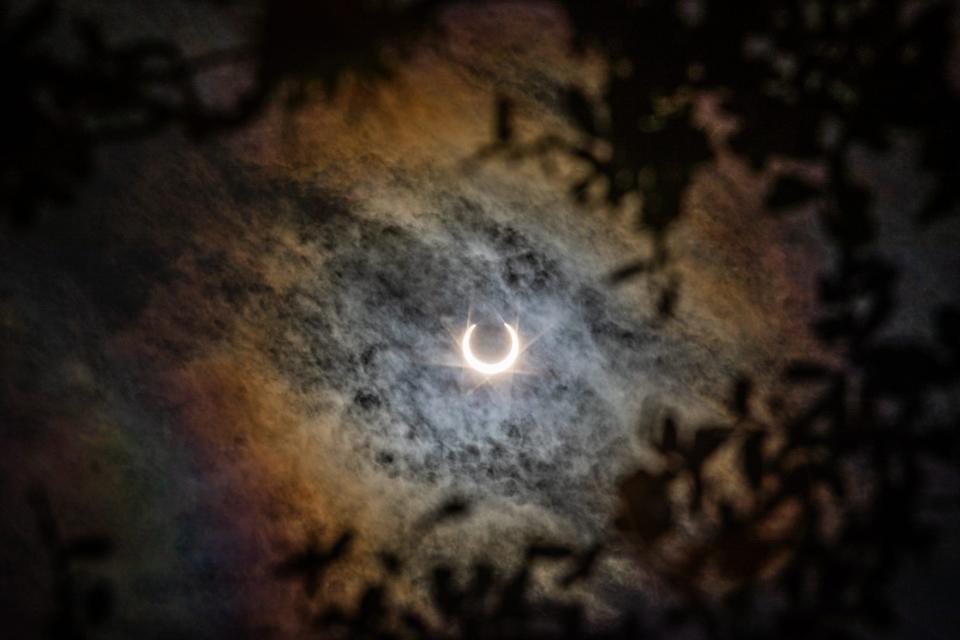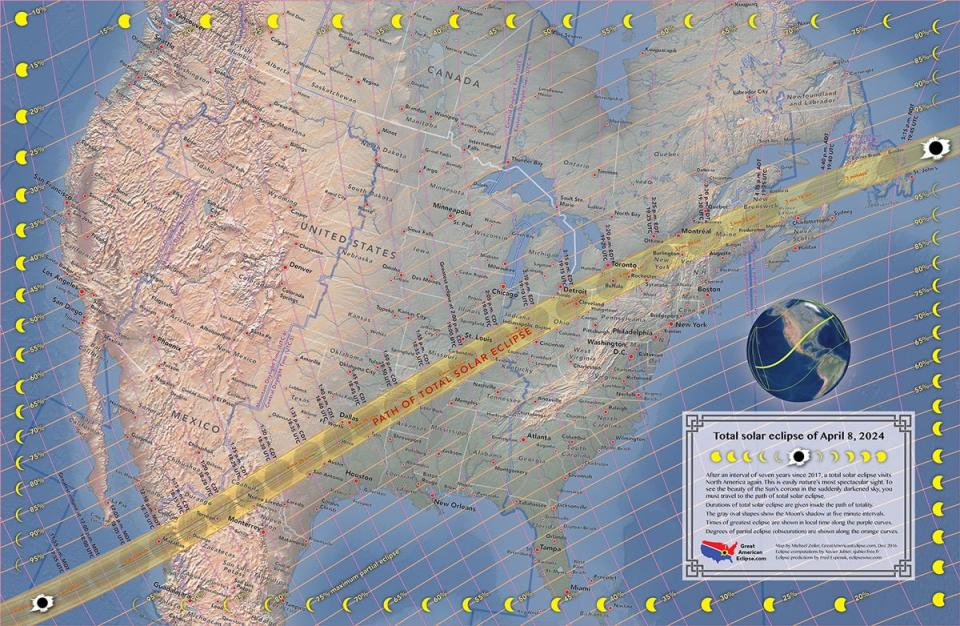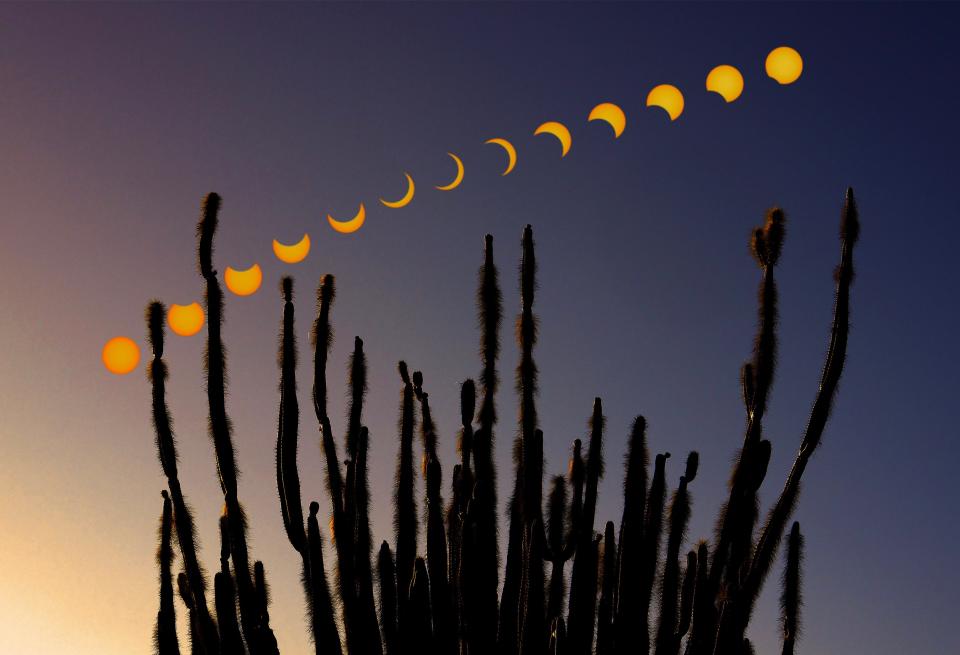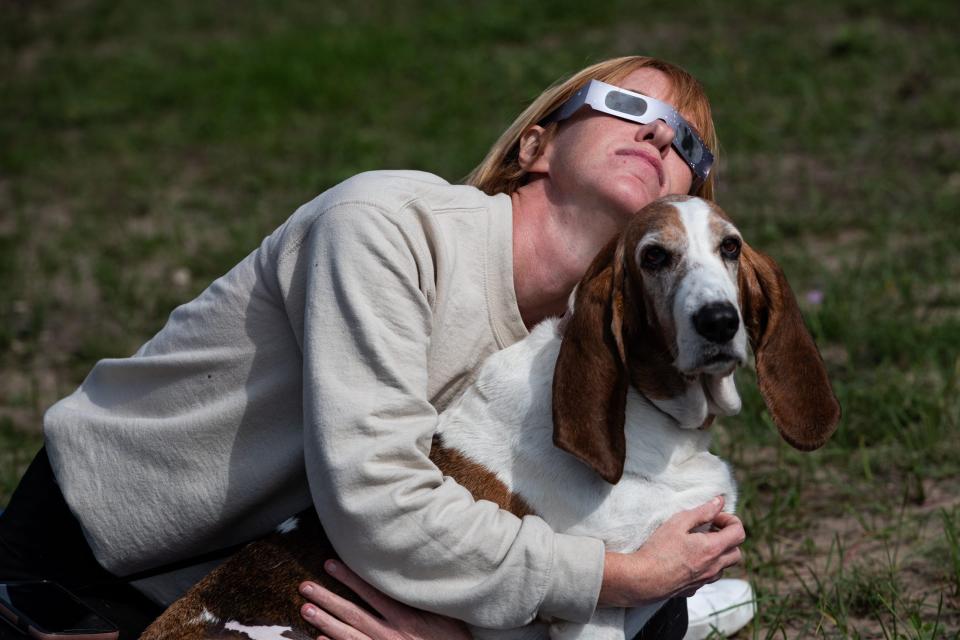A total solar eclipse in April will cross 13 US states: Which ones are on the path?
On April 8, skygazers along the wide-sweeping arc of the Great North American Eclipse's path will step outside to catch a rare glimpse of the sun while the Earth becomes shrouded in darkness.
For just the second time in seven years, day will suddenly become night for a few brief, wondrous minutes as the orbiting moon blocks the sun's light along a southwest-to-northeast path across the continent.
Millions of people already reside along the path of totality stretching from Texas to Maine in the U.S. And in the months ahead, countless tourists eager to witness the spectacular event are expected to make a journey to one of the many cities that will experience the eclipse.
Here's what to know about the total solar eclipse's path of totality, and how you can prepare to see it as it passes over Mexico, the United States and Canada:

When is the 2024 total solar eclipse? Your guide to glasses, forecast, where to watch.
What is a total solar eclipse?
Any celestial object like a moon or a planet that passes between two other bodies can create an eclipse by obscuring the view of objects like the sun.
A total eclipse occurs when the moon appears as the same size as the sun and blocks the entire disk, leading to a period of darkness lasting several minutes. The resulting "totality," whereby observers can see the outmost layer of the sun's atmosphere known as the corona, confuses animals – causing nocturnal creatures to stir and bird and insects to fall silent.
When a solar eclipse reaches totality, scientists are also presented with an uncommon opportunity to study the corona that is usually shielded by the sun's bright surface.
You may remember that only last October, something call an annular solar eclipse passed over the United States.
At the time, the moon wasn't close enough in its orbit of our planet to completely block out the sunlight when it passed between the sun and Earth. Instead, the eclipse resulted in a "ring of fire" effect when the moon appeared as a smaller disk in front of the sun, creating a bright halo of light.

What is the eclipse's path of totality?
The 115-mile-wide path of totality will cross North America, passing over Mexico, a wide swath of the the United States and Canada.

Mexico's pacific coast will be the first location in continental North America to experience totality, which will occur at about 11:07 a.m. PDT, according to NASA.
The longest duration will be near Torreon in Mexico at 4 minutes and 27 seconds, almost double that of 2017, according to estimates from eclipse cartographer Michael Zeiler at GreatAmericanEclipse.com.
To see the exact path of totality, check out an interactive map created by French eclipse expert Xavier Jubier.
Where can I see the eclipse in the U.S.?

In the United States alone, 31 million people already live inside the path of totality, according to the Great American Eclipse. Of course, that figure doesn't even account for the tourists sure to flock from all over for a chance to be there when darkness falls.
As the moon's shadow travels northeast, totality in the U.S. will begin in Texas as it cuts diagonally across the country and eventually enters the maritime provinces of Canada.
The Great North American Eclipse, as it's known, will trace a narrow path of totality across 13 U.S. states. Small parts of Tennessee and Michigan will also experience the eclipse, NASA says.
Here are the major cities in each state where you can expect to experience totality in the United States (note that the included times do not account for when the partial eclipse begins and ends):
Dallas, Texas: 1:40-1:44 p.m. CDT
Idabel, Oklahoma: 1:45-1:49 p.m. CDT
Little Rock, Arkansas: 1:51-1:54 p.m. CDT
Poplar Bluff, Missouri: 1:56-2:00 p.m. CDT
Paducah, Kentucky: 2-2:02 p.m. CDT
Carbondale, Illinois: 1:59-2:03 p.m. CDT
Evansville, Indiana: 2:02-2:05 p.m. CDT
Cleveland, Ohio: 3:13-3:17 p.m. EDT
Erie, Pennsylvania: 3:16-3:20 p.m. EDT
Buffalo, New York: 3:18-3:22 p.m. EDT
Burlington, Vermont: 3:26-3:29 p.m. EDT
Lancaster, New Hampshire: 3:27-3:30 p.m. EDT
Caribou, Maine: 3:32-3:34 p.m. EDT
Other major cities along the eclipse's path of totality include San Antonio and Austin, Texas; Indianapolis; and Rochester and Syracuse, New York.
You may want to see it while you can: For North America, the next total solar eclipse won't be until 2033, according to NASA.
How to safely view the eclipse

Unlike other solar eclipses, a total eclipse offers spectators a chance to gaze upon the spectacular sight with the naked eye.
However, you'll have to wait for the proper moment before removing your protective eyewear to avoid exposing yourself to the sun's powerful retina-damaging rays. You'll know its safe to fully take in the display when the moon blocks the sun's face and the sky turns dark, leaving only the solar corona visible.
But until that moment, NASA still advises spectators to ensure they have the safe – and simple – equipment needed for solar viewing.
Certified eyewear is held to an international safety standard and is 100,000 times darker than most sunglasses to block nearly all visible, infrared and ultraviolet light. To make it easy, the American Astronomical Society maintains a curated list of approved vendors.
Some places even offer them for free.
Another simple method is to create your own pinhole projector to project the sun onto a nearby surface. The American Astronomical Society helpfully offers instructions to set them up.
Eric Lagatta covers breaking and trending news for USA TODAY. Reach him at [email protected]
This article originally appeared on USA TODAY: Total solar eclipse 2024 path of totality: What states can see it
